Short Game Swings
- by Kelvin Miyahira
The greatest golfer of all-time, Jack Nicklaus was so dominant with his long game that he didn’t need a great short game when he was younger. Thus, he developed his short game later in his career as he began to lose his edge in driving distance. But Tiger Woods had a tremendous short game from the time he was a teenager and kept improving it until a couple of years ago when he started “fiddling” with it.
Under the guise of making things simpler by transforming Tiger’s release in his full swing to the same as in his chipping, pitching and putting, Sean Foley changed Tiger’s whole short game mechanics. Did it make him better? How about the opposite? We’ve now seen Tiger chunk a pitch shot into the water on a simple little 50 yard shot. His normally tremendous putting has been quite inconsistent lately. Now, after two years of trying to change Tiger’s putting stroke, Foley says, “Maybe you should go back to your old putting stroke?” Then he wins at the Chevron World Challenge. But, did everyone forget why he changed it in the first place? Not likely.
From March 2011, here’s what Tiger said, “I have to change everything. It's the whole release pattern…how I release the putter, how I release the short game, how I release irons, drivers, they are all related. You just can't have one swing and not have another; they are all interrelated.” He added, “You want to have the same type of swing with the putter all the way up to the driver. It's the same motion just smaller.” Sounds like he drank a Big Gulp of Kool Aid maybe?
Is Simple Better?
People are attracted to simple ideas because many times simple is better. But do we really want to use the same swing for everything from putts, to chips/pitches and all the way up to the driver? Is it possible to be the best driver (distance) and have enough distance/accuracy with irons and have the best wedge game by using one type of swing?
If we take this idea to other sports, it just does not make any sense. Do we ask a baseball pitcher to use the same release for a fastball as a curve or slider? No. Does a basketball player shoot the same way on each shot whether there is a giant 7’ 4” center in front of him or not? No. In tennis, does the player hit each forehand with the same motion whether the ball is high or low, crosscourt or down the line? Of course not. Does a pro surfer surf each wave the same way? No. Variation is a part of every sport. The elite athletes are always able to do what is required and adapt to each different situation.
Given that in other sports, should the 2nd greatest golfer of all time be asked to keep things simple by having one release type for all shots?
If you’ll go back to John Andrisani’s book “The Short Game Magic of Tiger Woods” published way back in 1998, Tiger used all sorts of swings to produce the shots he wanted. If he wanted to hit a lob, he cupped his left wrist on the backswing and flipped it. If he wanted to hit a chip and run he’d bow the left wrist at impact. If he wanted to add spin, he opened his stance more. The bottom line is that Tiger had mastery of all these shots and could change the trajectory/spin at will by changing his release. I have seen him hit several different shots and different heights of shots with the same backswing. The genius is in his ability to picture what he wants to do and change his release to produce the shot that he wanted. Can everyone do this? Sure. Maybe not as well as Tiger but it is the one area where having his strength and speed are not requirements to being able to hit these shots. Therefore everyone should be able to master a few of these shots, release styles and swings to shave strokes off their score.
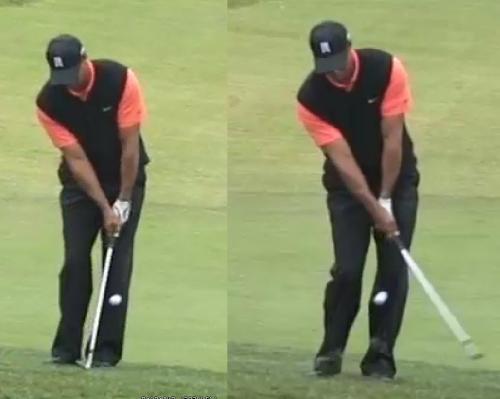
Here’s Tiger hitting two different shots from the same spot in the rough on the left side of the 18th green at Torrey Pines. One is a low pitch and run and the other is a slight lob. Can you tell which is which?
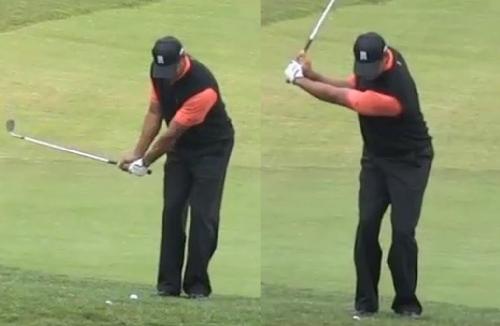
He also used two different backswings for the same distance of shot.
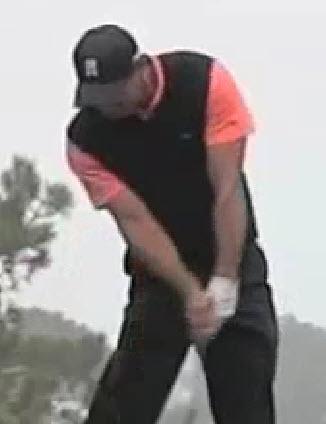
And here’s Tiger hitting a driver.
Embrace Complexity
After writing the series on promoting the benefits of lag for maximizing your ability to hit longer drives and crisper iron shots, I thought it would be important for everyone to know that increasing or holding lag on your control, short game shots (100 yards and in) can be detrimental. In fact, the dreaded cast and flip becomes your best friend when you’re in the bunker or trying to lob one over. Yet try to hit a punch shot from under the trees and it is your worst enemy. So it’s obvious that in order to play great golf you need a variety of shots/releases to hit a multitude of shots.
The best short game players in the world can create different impact conditions by changing the variables of shaft lean, clubface rotation and release type. But they also change the way they use their body. In order to create a swing that has maximum control you have to start by taking out the most powerful moves and muscles. So let’s start by learning how the short game swing is different than your power swing and how anyone can improve their control by following some simple rules.
Eliminate Power Moves
I once had a long drive student many years ago that could hit his sand wedge 150 yards but wanted more control of his three-quarter and half swings. So we hit from the 150 marker, then paced off ten yards at a time and dropped a few balls at 140, 130, 120, 110 and 100 yards. He was good at 150 yards but then an interesting thing happened. As we got closer, we found that his three-quarter and half swings could fly the ball just as far as his full swings. With a half swing from 100 yards, he flew some balls 40 yards over the green into a river! He was just so explosive that he could not control his power on these partial swings. What to do?
The answer was to remove some of his power moves. So which power moves should we take out?
Less Wrist Hinging on the Backswing
Since wrist hinging or radial deviation is part of lag, it obviously can increase clubhead speed. So let’s start by removing the full wrist hinging.

On the left is a semi-lob shot by Jason Day. The key to good pitching is using your arm swing without a lot of wrist hinging (radial deviation). Notice how wide he keeps his right arm.
This is where many golfers have difficulty. They tend to use a full wrist cock with only a half swing. If you’re going to have a full backswing, you can have a full wrist hinge. But if you’ve got a half swing, use half the amount of wrist hinging. If you’re going to use a three-quarter swing, then use three-quarters of wrist hinging and so on.
The only time to use the full wrist hinging is for full lobs or a full swing.
Wrist Hinging Variations - Left Forearm Rotation
Chips
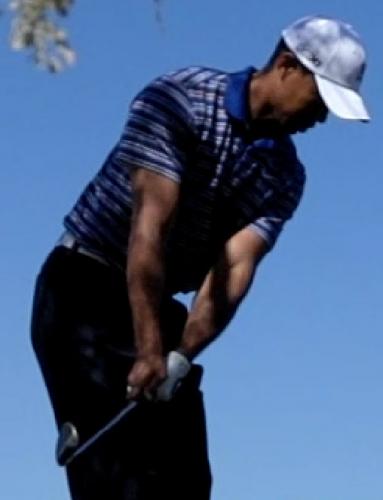
On chip shots, the left wrist should supinate along with left wrist flexion on the backswing. Tiger’s left wrist flattens as he does this.
The right wrist extends and both wrists will have a slight ulnar deviation creating a slightly inside takeaway and a clubface that stays square on the backswing. There is no radial deviation in this backswing.

On the left, Tiger is slightly supinating his left forearm while using left wrist flexion (bowing) and right wrist extension (cupping) to hit a pitch and run which is similar to a chip shot. There is very little radial deviation in this backswing.
On the right, he uses slight left forearm pronation/right forearm supination, slight left wrist extension/right wrist flexion and radial deviation in both wrists. This creates a backswing with more left wrist cupping and a more open clubface at the top of the backswing. This is how Tiger hit his lob shots.
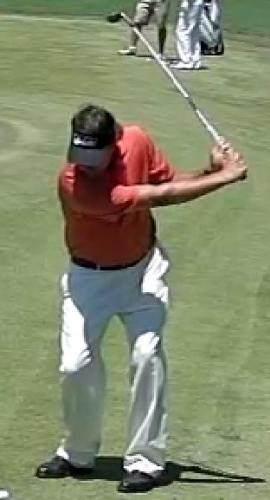
Here’s Phil with the clubface wide open at the top. This is for a full lob from less than 10 yards away.
Cast it!
Since lag can really add to clubhead speed, shouldn’t that be removed too? Yes! So start the downswing by casting (removing radial deviation) and extending both arms. By casting, it also eliminates any right shoulder external rotation. The great ones slowly release the right shoulder internal rotation early in the downswing.
Take a look at Justin as he “casts” or releases the club at the start of his downswing. He’s got the PGA tour record for having four chip-ins during one round and is one of the best short game players around.


Contrast that to JB Holmes.

JB increases his lag whereas Justin decreases or casts it. JB is also holding his left arm to his chest and storing energy in his torso as well.
We know who is the better short game, control player.
See Bubba Watson holding lag?
Legs/Hips too powerful
Most of your power comes from your legs and hips. So how about we remove them too?
Here’s a close up of Bubba using a lot more leg/hip power than the best control players. Using your legs and hips are like having a turbo boost and can lead to excess distance when you don’t need it.
Now notice how quiet Justin keeps his legs during the swing.
Could it be possible that these two bombers have not figured out how to hit all of these short game shots?
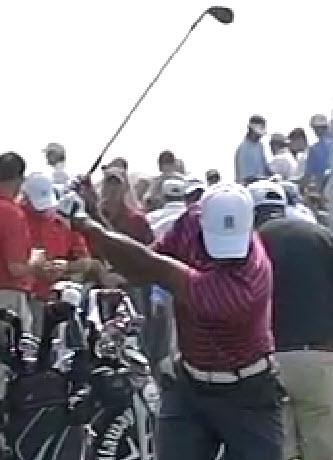
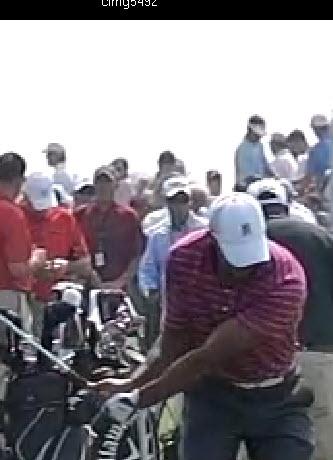
Tiger’s casting it like the great short game players!

On the left Tiger is hitting a three-quarter swing wedge while on the right he’s hitting a driver. Notice the decrease in lag on the pitch shot. His right shoulder is releasing slow and smoothly as well.
The driver swing shows that he’s still storing energy by holding right shoulder external rotation and holding more radial deviation.
Is this why Tiger could bomb it and still have a tremendous short game? Tiger had all the shots.
Increase moment of inertia
By casting, you are increasing the moment of inertia. Extending the arms and club away from the body moves the mass farther from your center of rotation, thereby making it more difficult for you to develop speed. This is like the ice skater spinning with his/her arms extended out. This slows the rotation.
Contrast that with holding lag and keeping the arms/club closer to your body. It is decreasing the moment of inertia thereby allowing you to develop more speed that can lead to an exponential increase in distance. This isn’t good when you’re seeking maximum control.
Remove Weight Shift
According to Jorgensen’s Physics of Golf, weight shift can increase distance by 10% or so. If you’re trying to hit a 100 yard shot, do you want a 110 yard shot? Not really. So using weight shift isn’t a good idea. The best short game players keep their weight on their left sides on the backswing and don’t need to shift it on the downswing thereby removing a potential power source that could have you hitting the ball over the green.




So here’s Justin with a pretty centered pivot on the backswing. At impact, he’s only slightly shifted left and only way after impact does it look like he shifts to his left side. Thus the weight shift is only cosmetic and not part of the hitting motion.
Or Reverse Weight Shift
On short pitches and chips there is even a small reverse head and hip movements by many players.
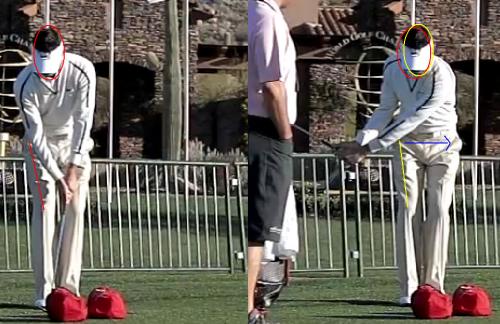
Here’s Charl Schwartzel with this slight reverse shift of the head and hips. Shifting to the left on the backswing makes sense since this takes away any chance for adding power of weight shift (by moving from right to left) and losing control.

His chest covers that ball and moves forward on the downswing.
Stall!

From this view, you can see that AK, hitting an iron shot on the left, has his whole body rotating at impact. His hips are rotated wide open at impact and his shoulders are turning on the tilted plane. This is evidence of the spine gears being connected and driving the body rotation through impact. Very powerful.
On the right, he’s hitting a bunker shot with his hips and shoulders stalling while flipping the club through. Very controlled.
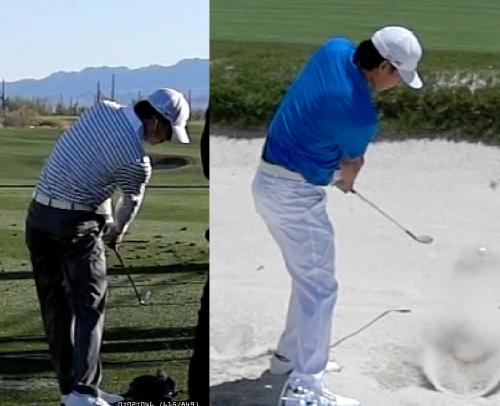
Post impact you can see the rotation of the body continues with the iron vs. the bunker shot is just flipping the club through. Notice the difference in the clubface positions.
Shoulders turn on similar plane as hips

With the power swing, Tommy Gainey’s shoulders are rotating on a more tilted plane. On a short pitch Fisher is turning his shoulders closer to parallel with his hips. This is especially true for chips.
Shoulders Catch up to the Hips
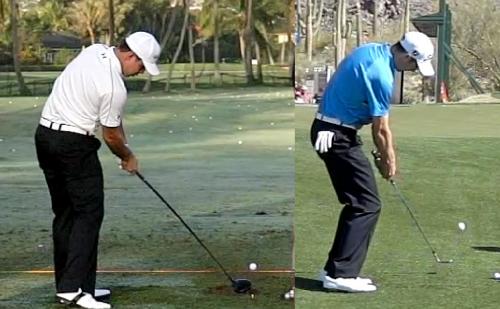
In short pitches and chips, the shoulders should catch up to the hips whereas in the power swing, this should not occur.
Use the Kinetic Chain
Is this starting to make sense? There is a time to use the kinetic chain, but it’s not for your power shots! It’s for your control shots. The typical sequence of a very good control player will use the kinetic chain. They will start the downswing with a minute movement of the legs, then rotate their hips, then decelerate their hips to turn off the lower body power in order to maximize control. This allows the golfer to use his less powerful shoulders and arms to create the speed in the swing.
Isn’t it ironic? The proponents of the kinetic chain tell you it’s going to help you hit the ball farther when the exact opposite is true. Hmmmmmm.
Justin Leonard
http://youtu.be/5qHOxwRj85Y
Here’s Justin Leonard again hitting a ¾ swing pitch shot. Notice the deceleration in his lower body to produce the controlled shot. This is a very important adjustment to make to reduce distance but gain accuracy.
Spine Movement
Here’s Ross Fisher who has a great short game.
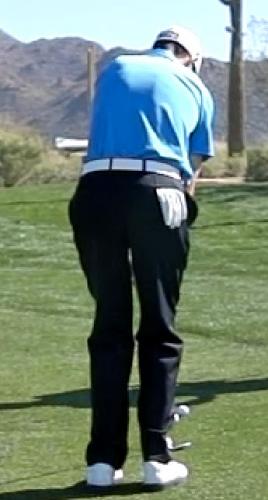
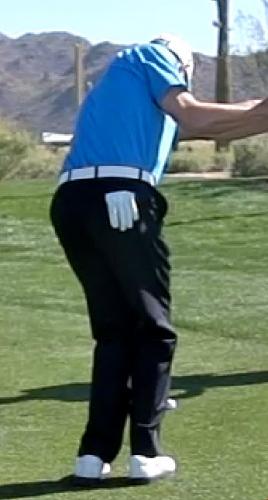
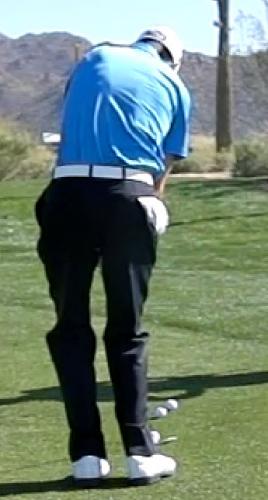
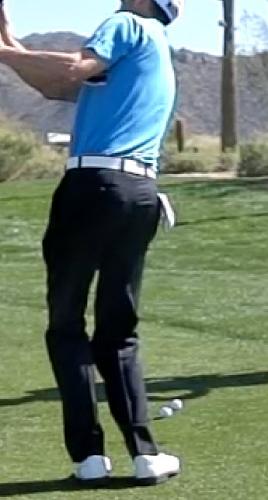
His movements show no lateral bending on the downswing. The power on a pitch shot like this comes from the obliques and the arms.
Instead of a powerful right side loading on the backswing, there is the opposite. While the upper body moves to the right, the lower body moves left on the backswing. Then on the downswing, the upper body moves to the left while the lower body moves to the right. In this way, the lower body is actually fighting the movements of the upper instead of helping. So it makes sense that this would provide more control of the speed.
Use Obliques not Spine Engine
As I have shown, the spine engine is the foundation for powerful, full body rotation that can help you hit the ball longer. So let’s not use it. By removing lateral bend on the downswing and instead using your obliques as your prime movers instead of stabilizers, you disconnect the spine gears that would normally engage your lower spine, legs and hips from the drive train.
The obliques are far less powerful than using your spine engine as a whole unit thus increasing the control of your speed. It’s like stomping on the gas pedal of your Prius vs. a Ferrari. You get a lot less changes in speed when you have less power. That’s helpful when you want control.
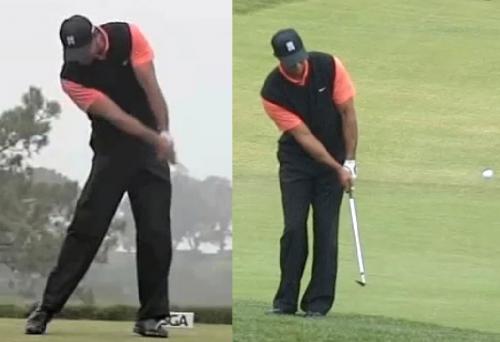
Here’s Tiger with a driver follow through showing the tilted shoulders, head falling away and full body rotation on the left. On the right, he’s hitting a pitch and run of about 30 yards. Notice his shoulders are turned more level with his lower body quiet. Even his head has lifted and moved forward so that the chest is more forward toward the target.
Thus, without the strong lower body drive that can potentially hit the ball too far, you will be creating the power with far less powerful obliques and upper body alone. This creates a very accurate, distance control swing that is very reliable.
Release Variations
Underflip it!
Most of the short game shots should use the underflip release. The hands can lead the club by just a little bit until just before impact. Then the club will pass the left forearm right at impact. This allows the use of the bounce of the club to strike the ground. This adds loft and spin for more control while reducing distance.
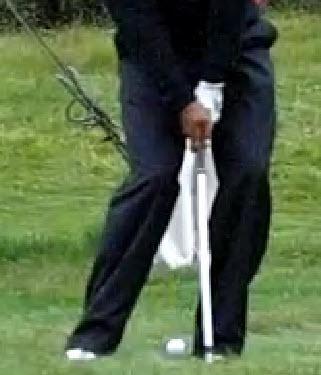
On lob shots, the club will pass a little earlier and have a bit more of a stall in the arms. Here’s Tiger using a flip release to hit a lob.
Keep the Clubface Open
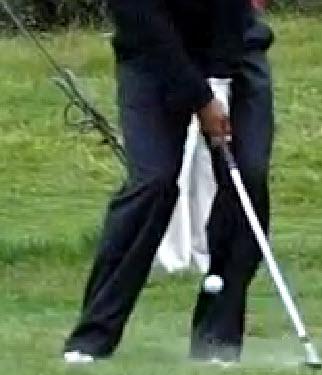
Notice the clubface stays open after impact to hit the lob. When flipping, it is important to realize that you have two choices; one is to flip while keeping the clubface open and the other is to flip while closing the clubface. For any shot requiring added loft, you would want to keep the clubface open.
Any flip with closing of the clubface will result in a hook spin shot which would be good for hitting a running shot but could make carry distance inconsistent since the greater the hook, the less carry distance you can expect while adding more roll to the shot. The majority of short shots should keep the face square to open on the follow through.

Here’s Steve Marino with a drive/holding hitting the “entire slab of bacon” instead of a bacon strip divot. Perhaps he’s another bomber that hasn’t learned that casting can be good on short shots? This can be a useful shot to hit the driving low wedge with a lot of spin in some situations but it can also drive these short shots way too far if it comes out hot.
Chip shot variations
Here’s Jason Day hitting two different chips from the side of the green. On the left, he drives the leading edge into the turf (drive/hold release) and holds his wrist angle going through. On the right, he uses a slight underfip release to slide the club through using the bounce of the club to slide through the grass. The left will create a lower more running shot whereas the shot on the right will have a little more loft and spin.
Angle of Attack
On the short swings there is a need to sometimes create a steeper angle of approach. Yes, you can use a slightly open stance and as Paul Runyon said and have your sternum over the ball or even in front of the ball at address. But this is not the answer. The key is not in the address position. Many pros actually have their sternum behind the ball (away from the target) at address. The key is at moving the sternum forward at impact. Having your chest “cover the ball” is very important!
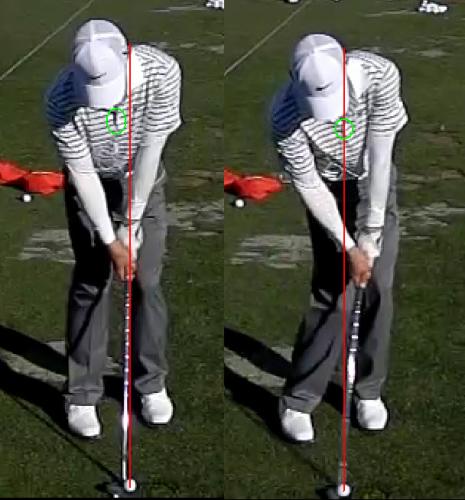
See where the placket (roughly where your sternum is) is on Anthony Kim’s shirt (in green circle)? At address it is behind the ball. At impact it is directly over the ball. This is his chest “covering” the ball. In addition to having his hands slightly in front of the ball at impact, this creates a steeper angle of attack for clean contact.
This also affects the angle you turn your shoulders on. In other words, the power swings that have your shoulders tilted at impact (rotating more vertically) should not be used in the control swings! The tilted or more vertical rotation of the shoulders is a result of lateral bending on the right side of your spine. But that’s a power position. You don’t want to use that power unless you really need to.
The reason is the lateral bending will cause your sternum to be farther behind the ball and along with the fact that you are using an early release to enhance control, the low point of your swing will be so far behind the ball that you’re a fat shot waiting to happen. If you do that enough, you’ll start standing up or pulling up with your arms and blade it over the green.
Power or Control Swing for Irons?
Tiger in his prime hit monstrous iron shots when needed. He once hit a 5-iron from 240 yards that had to fly over the creek and land softly to a front pin placement. Or a 6-iron from 213 yards from a fairway bunker at the Canadian Open that had to carry water the entire way to reach the green.
Or he could finesse the short iron shots with accuracy unrivaled. Check out this clip from the year 2000. Two of the shots are gigantic and two are controlled, accuracy swings.
http://www.youtube.com/watch?v=wZTuhV4v0H4&feature=results_main&playnext=1&list=PL06961F67F1F5F4B5
Given that Tiger played the best golf of all time during this stretch from 1999 to 2001 doing these fantastic shots, it is pretty obvious that this is the gold standard. One can argue that we need a control swing, but there are also times where bombing a high 240 yard shot over water with a 5 iron is the only way to keep a ball from going over the green and try to make an eagle. If Chip Beck could hit a 230 yard shot over water with ANY club at the 1993 Masters, he might have had a better chance of catching Bernhard Langer.
There’s no doubt that Tiger had both types of swings in his arsenal and it made him the most dominating player since Jack Nicklaus.
The Michelle Wie saga
This is perhaps one of the best examples of a great future being ruined by the thoughts of being accurate at the cost of distance. Or shall we say using your short game accuracy and control swing for your power shots? MW could carry her drives over 275 yards when she was 13 years old and with a skinny, lanky body. Thus, with a bit of roll, she could easily hit 300 yard drives. Now, she’s bigger, stronger and more fit, but averaged 266 yards (with roll) off the tee last year.
Notice how she holds the left hip in internal rotation (IR) and stalls her lower body from about when the shaft is horizontal through to the 3 o’clock position now. If anything there’s a little jump with no explosive rotation like she did years ago. There’s none of the dynamic body action that made her great. It’s a pretty swing but is it the swing of a dominant #1 player or Laura Baugh?
One swing for all shots?
Hopefully this will help all the bombers understand what they have to do to increase their control, accuracy and variety for their wedge shots. There are so many different types of shots you face during a round of golf; it would help you to meet those challenges if you are able to understand the slight changes you need to make in order to be a better short game player. It does not mean you have to sacrifice your driving distance or hit your irons 10-20 yards shorter to be “accurate.” Just keep bombing it and learn the short game as Phil and Tiger 2000 are or were able to.
The human brain possesses the ability to program different swings for different shots. Why should we simplify to make the game tougher? Why not trust the genius of the human brain to conjure up the shot we want and let it construct the right swing for the situation. And if Bubba or JB could learn to release earlier on their pitch shots, it would make them far better short game players without having to sacrifice the awesome driving distance advantage they now have.
Also for those of you who use your control swing for your power shots or who are eliminating any of the aforementioned power moves (because a teaching philosophy says so) and suffering from a lack of distance, it does not have to be that way. If you are already accurate and have a good short game, there is no need to change anything in your short game or short iron accuracy swings to hit the ball longer. Why not be 20-30 yards up the fairway and be able to hit shorter irons into the greens? Wouldn’t you be more accurate with an 8-iron in your hand than a 5-iron?

